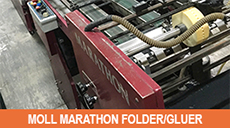
|
|
| Home › Articles › Here |

|
|||||||||||||||
| By: Nick Howard | Date: January 2012 | Contact the Author |
|||||||||||||||
As we entered 2012, what questions regarding your pressroom floor can be important to you? How can I extend the useful life of my sheetfed equipment? There may be a lot of reasons why some of us are working much more profitably than others. I have put together a few discussion points that have been brought up many times before but today seem even more vital. Not everyone can justify a new press every one or two years. So, keeping what you have in the best possible order also demands focusing not only on the machine but other outside influences.  Knowing What You Have Knowing What You HaveSounds pretty basic, but is it? For example, do you know the profitability of each piece of equipment in terms of what it costs you to keep and operate it? If not, then start with a breakdown of each key item. Look at the book value and pinpoint the hourly costs when using it as well as the cost just to have it hooked up and on the floor. Years ago, most printers had a couple presses that were used for selective accounts. Today, one cannot afford the luxury of doing so, even if that asset is paid for and supposedly costs nothing when not in use. Consider labour input, floor space and utilities cost to determine whether or not it is prudent to keep it. Finally, look at the option of putting this occasional print work on another press. Perhaps, you would be surprised to find that, in fact, the costs outweigh the advantages of certain machines.  Know The Condition Of Your Equipment Know The Condition Of Your EquipmentWithout benchmarking to an industry standard (and this doesn’t mean calibrating to your pre-press), there is no way of understanding what the machine can do or not do. By understanding the equipment features, you can rationalize if your press or other piece of equipment can operate profitably and compete. Ideally, an assessment of this kind can be carried out using staff in the plant and you may also want to consider some outside help from, say, the manufacturer of the machine in order to determine where the press fits in a 1-10 scenario. As part of this study, determine what features work and what you use or don’t use. A good example may be the automated blanket washers. If they are fitted but don’t work then find out why and determine how this impacts the efficiency.  Create A Sound Preventative Maintenance Program Create A Sound Preventative Maintenance ProgramAgain the manufacturer can be a great help as they should have already developed such a program. Keep this PM very simple and straight forward. I don’t know how many “empty” PM log books I have seen. Just like New Year’s resolutions, these in-house programs start out with a bang and end with empty pages. So, start simply. What is really important to lengthen the life of any machine is simple. Create a once or twice a week lubrication checklist. Make it a single page and easy to fill out. Start by having all Operators know how to do the work. You would be surprised at how few actually do. Standardize your lubricant supplies. Order from one source and always have at hand. Store along with filters in a specific area and not mixed up with other machine related items. Having an excellent lubrication program will by itself lengthen the life of your equipment more than anything else you can do. A by-product of lube is that the Operators also get to see and discover potential machine failures at the same time!  Clean Up The Shop Floor Clean Up The Shop FloorAnother simple and often repeated suggestion as well as generally ignored. Our plant is very clean and organized. It must be said that this did not happen overnight. At first, we laid out a plan and then made schedules and “to do lists”. These, although conceived to be the right approach, turned out to be difficult to abide by. The reason was that we actually created too many new rules and procedures. Now, we look at how best to get the plant ship shape and actually reduce the amount of administration and paperwork. An example is as simple as a broom. Try and find one in your plant. If you’re like me then you have bought way more brooms than you actually can find and that’s because they are never put back where they belong. Make a place for them and mark it. This will encourage people to actually put them back. The same can be said for a variety of other related items in your plant. A clean and organized plant will take time but eventually the staff will waste less of it looking for things which adds up to more potential time producing. |
|||||||||||||||
|
|||||||||||||||





